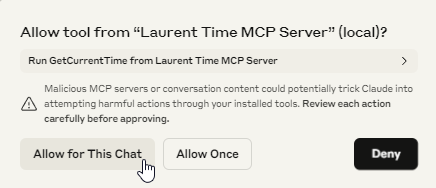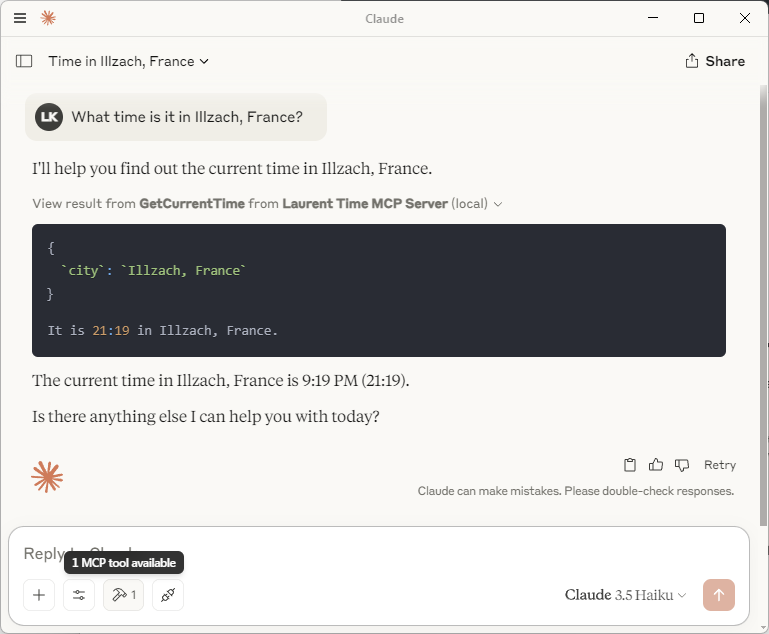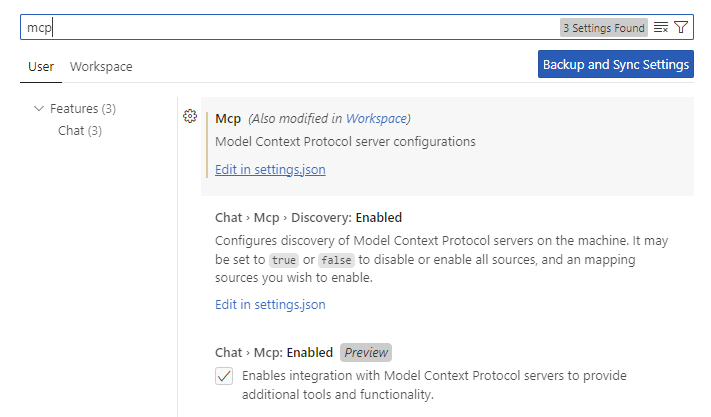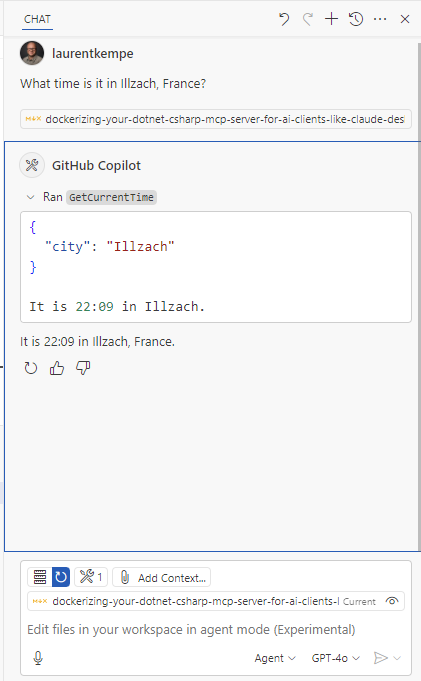My previous post showed how easy it is to develop a .NET C# MCP server and write a client able to communicate with it. Now, the question is how we can distribute our MCP server to be used by AI clients. In this post, we’ll leverage the knowledge acquired from my previous posts to explore how to dockerize your .NET C# MCP server.
Introduction
Model Context Protocol is on fire 🔥, and it’s great to get support for it on .NET through an official C# SDK!
As I wrote in my previous post, the MCP server is a console application that uses the STDIO transport protocol. I wasn’t satisfied with how I had to specify the path in the MCP Client. So, I searched for another approach, and thanks to the great post from Philippe Charrière, Creating an MCP Server in Go and Serving it with Docker, I realized using a Docker container would be a great idea 💡.
Requirements
- Docker installed on your machine.
- Claude Desktop or any other MCP client like Visual Studio Code Insider installed on your machine.
- .NET 9 SDK for sure.
Update our MCP server
The code itself doesn’t change at all, from the previous post.
var builder = Host.CreateEmptyApplicationBuilder(settings: null);
builder.Services
// 👇 We build an MCP Server
.AddMcpServer()
// 👇 Uses Stdio as transport protocol
.WithStdioServerTransport()
// 👇 Register all tools with McpToolType attribute
.WithTools();
await builder.Build().RunAsync();
// 👇 Mark our type as a container for MCP tools
[McpToolType]
public static class TimeTool
{
// 👇 Mark a method as an MCP tools
[McpTool, Description("Get the current time for a city")]
public static string GetCurrentTime(string city) =>
$"It is {DateTime.Now.Hour:00}:{DateTime.Now.Minute:00} in {city}.";
}We will use the .NET SDK capability to publish our application as a Docker container. This is a great way to distribute our MCP server, as it will be easy to run on any machine with Docker installed. For that we need to add few lines to the csproj configuration to enable the .NET SDK built-in Docker support. This is done by adding the following lines:
<PropertyGroup>
<!-- 👇🏼 Enable SDK container support -->
<EnableSdkContainerSupport>true</EnableSdkContainerSupport>
<!-- 👇🏼 Define the container image name created -->
<ContainerRepository>laurentkempe/mcpserverdocker</ContainerRepository>
<!-- 👇🏼 Define the container base image used to build our Docker image -->
<ContainerBaseImage>mcr.microsoft.com/dotnet/runtime:9.0-alpine</ContainerBaseImage>
<!-- 👇🏼 Targeting Linux as the OS and an x64 architecture -->
<RuntimeIdentifier>linux-x64</RuntimeIdentifier>
</PropertyGroup>As our MCP server is a console application, and it is using STDIO transport protocol, we don’t need to expose any port. We are using the .NET Alpine base image to keep the container lightweight.
Publish our MCP server
To publish our MCP server locally, we need to run the following command in the root of our project:
dotnet publish /t:PublishContainerThen the Docker image will be created in the local Docker registry. You can check that by running the following command:
❯ docker images
REPOSITORY TAG IMAGE ID CREATED SIZE
laurentkempe/mcpserverdocker latest 2f25817e97b4 15 seconds ago 133MBUpdate our MCP client to use the dockerized MCP server
To use our dockerized MCP server, we need to update the MCPClient configuration with the following lines:
// 👇🏼 Configure the Model Context Protocol server to use
var config = new McpServerConfig
{
Id = "time",
Name = "Time MCP Server",
TransportType = TransportTypes.StdIo,
TransportOptions = new Dictionary<string, string>
{
// 👇🏼 The command executed to start the MCP server
["command"] = "docker",
["arguments"] = "run -i --rm laurentkempe/mcpserverdocker"
}
};This is much nicer than specifying the path to the MCP server executable, but can be cumbersome to build the container image each time you change the server code.
Running our own client
To run the client, simply execute dotnet run. The client application starts, then starts the our newly created docker container with our Time MCP Server, interacts with the AI model, and returns the current time in Illzach, France.
Hello, official MCP csharp-sdk and Docker MCP Server!
What is the current (CET) time in Illzach, France?
trce: Microsoft.Extensions.AI.LoggingChatClient[805843669]
GetResponseAsync invoked: [
{
"role": "system",
"contents": [
{
"$type": "text",
"text": "You are a helpful assistant delivering time in one sentence\r\nin a short format, like 'It is 10:08 in Paris, France.'"
}
]
},
{
"role": "user",
"contents": [
{
"$type": "text",
"text": "What is the current (CET) time in Illzach, France?"
}
]
}
]. Options: {}. Metadata: {
"providerName": "ollama",
"providerUri": "http://localhost:11434/",
"modelId": "llama3.2:3b"
}.
trce: Microsoft.Extensions.AI.LoggingChatClient[384896670]
GetResponseAsync completed: {
"messages": [
{
"role": "assistant",
"contents": [
{
"$type": "functionCall",
"callId": "7DFFB38A",
"name": "GetCurrentTime",
"arguments": {
"city": "Illzach"
}
}
]
},
{
"role": "tool",
"contents": [
{
"$type": "functionResult",
"callId": "7DFFB38A",
"result": {
"content": [
{
"type": "text",
"text": "It is 20:54 in Illzach."
}
],
"isError": false
}
}
]
},
{
"role": "assistant",
"contents": [
{
"$type": "text",
"text": "The current time (CET) in Illzach, France is 20:54."
}
]
}
],
"responseId": "2025-03-27T20:54:27.1080391Z",
"modelId": "llama3.2:3b",
"createdAt": "2025-03-27T20:54:27.1080391+00:00",
"finishReason": "stop",
"usage": {
"inputTokenCount": 374,
"outputTokenCount": 39,
"totalTokenCount": 413,
"additionalCounts": {
"load_duration": 7512529000,
"total_duration": 8348169800,
"prompt_eval_duration": 365028500,
"eval_duration": 445809800
}
}
}.
The current time (CET) in Illzach, France is 20:54.Configure Claude Desktop
To configure Claude Desktop to use our MCP server, we need to update the configuration file %APPDATA%\Claude\claude_desktop_config.json with the following content:
{
"mcpServers": {
"Laurent Time MCP Server": {
"command": "docker",
"args": [
"run",
"-i",
"--rm",
"laurentkempe/mcpserverdocker"
]
}
}
}Using our MCP server with Claude Desktop
Once the configuration is done, we can start Claude Desktop and see our server and time tools available in the list of tools. When asking about the time in a city will use our MCP server to get the answer, but first we need to allow the tool to be used.

Then we will see that our MCP server is called and get an answer which is used by the LLM to answer the question.

Using our MCP server with Visual Studio Code
Visual Studio Code Insiders now supports MCP servers. To configure it, follow these steps:

Click on Edit in settings.json and add the following configuration:
{
"mcp": {
"inputs": [],
"servers": {
"laurent-mcp-server-time": {
"command": "docker",
"args": [
"run",
"-i",
"--rm",
"laurentkempe/mcpserverdocker"
],
"env": {}
}
}
},Open Edit with Copilot, select Agent, and see one tool listed

Clicking on the icon you should see the tool available in the MCP server.

Then, we can ask Copilot our question and see the answer after approving the tool execution.

Conclusion
The future of AI is incredibly exciting, and the Model Context Protocol (MCP) is paving the way for seamless integration between tools, platforms, and AI clients. By containerizing your .NET C# MCP server, you’re not only simplifying deployment but also unlocking the potential for scalable, cross-platform AI solutions. Whether you’re using Claude Desktop, Visual Studio Code, or other MCP-compatible clients, this approach demonstrates how easy it is to bridge the gap between AI and real-world applications.
As MCP continues to evolve, it’s clear that we’re just scratching the surface of what’s possible. The combination of open standards, powerful SDKs, and containerization is setting the stage for a future where AI tools are more accessible, interoperable, and impactful than ever before. So, dive in, experiment, and be part of this transformative journey. The future of AI with MCP is here, and it’s brighter than ever! 🚀
Get the source code on GitHub aiPlayground/MCPServerDocker and if you like it please give it a star ⭐️.
